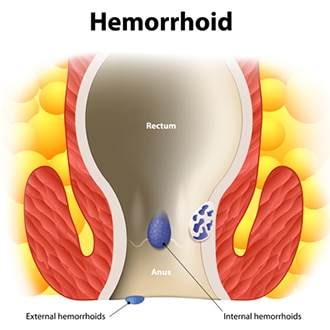Definition & Facts of Hemorrhoids
In this section:
- What are hemorrhoids?
- How common are hemorrhoids?
- Who is more likely to get hemorrhoids?
- What are the complications of hemorrhoids?
What are hemorrhoids?
Hemorrhoids, also called piles, are swollen and inflamed veins around your anus or in your lower rectum.
The two types of hemorrhoids are
- external hemorrhoids, which form under the skin around the anus
- internal hemorrhoids, which form in the lining of the anus and lower rectum

How common are hemorrhoids?
Hemorrhoids are common in both men and women1 and affect about 1 in 20 Americans.2 About half of adults older than age 50 have hemorrhoids.2
Who is more likely to get hemorrhoids?
You are more likely to get hemorrhoids if you
- strain during bowel movements
- sit on the toilet for long periods of time
- have chronic constipation or diarrhea
- eat foods that are low in fiber
- are older than age 50
- are pregnant
- often lift heavy objects
What are the complications of hemorrhoids?
Complications of hemorrhoids can include the following:
- blood clots in an external hemorrhoid
- skin tags—extra skin left behind when a blood clot in an external hemorrhoid dissolves
- infection of a sore on an external hemorrhoid
- strangulated hemorrhoid—when the muscles around your anus cut off the blood supply to an internal hemorrhoid that has fallen through your anal opening
- anemia
References
This content is provided as a service of the National Institute of Diabetes and Digestive and Kidney Diseases
(NIDDK), part of the National Institutes of Health. NIDDK translates and disseminates research findings to increase knowledge and understanding about health and disease among patients, health professionals, and the public. Content produced by NIDDK is carefully reviewed by NIDDK scientists and other experts.

